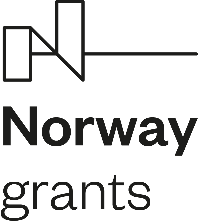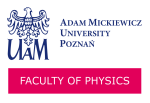STATICS AND DYNAMICS OF 3D MAGNETIZATION TEXTURES – THEORY AND SIMULATIONS (3DMATEX)
Statyka i dynamika tekstur magnetyzacji w 3D (3DMATEX)




Project:
Founded from the Norwegian Financial Mechanism 2014-2021, NCN POLS call [POLS (ncn.gov.pl)], Contract No. UMO-2020/37/K/ST3/02450, PI: prof. Olena Tartakivska (emails: olena.tartakivska@gmail.com, olena.tartakivska@amu.edu.pl )
Research Team:
Prof. Olena Tartakivska, PI, (emails: olena.tartakivska@gmail.com, olena.tartakivska@amu.edu.pl )
Prof. Konstyantyn Guslienko, Main investigator (email: kostyantyn.gusliyenko@ehu.eus )
Prof. Maciej Krawczyk, Main investigator, local coordinator (email: krawczyk@amu.edu.pl)
Mgr Yuliia Karhlan, investigator (emails: yuliia.kharlan@amu.edu.pl , julia-lia-a@ukr.net )
Mgr Dariia Popadiuk, investigator (emails: dariia.popadiuk@amu.edu.pl , dashapopadiuk43@gmail.com )
Dr Piotr Graczyk, investigator (email: graczyk@ifmpan.poznan.pl )
Mgr Krzysztof Sobucki, cooperation (email: krzsob@amu.edu.pl )
News
New manuscript:
D. Popadyuk, E. Tartakovskaya, M. Krawczyk, and K. Guslienko,
Emergent magnetic field and non-zero gyrovector of the toroidal magnetic hopfion
has been submitted to pps Rapid Letters.
Magnetic hopfions are localized magnetic solitons with non-zero 3D topological charge (Hopf index). Here we present an analytical calculation of the magnetic hopfion gyrovector and show that it does not vanish even in an infinite sample. The calculation method is based on the concept of the emergent magnetic field. The particular case of the simplest non-trivial toroidal hopfion with the Hopf index |Q_H |=1 in the cylindrical magnetic dot is considered and dependencies of the gyrovector components on the dot sizes are calculated. Non-zero hopfion gyrovector is important in any description of the hopfion dynamics within the collective coordinate Thiele´s approach.
10.04.2023
Presentation on Intermag 2023 accepted:
K. Sobucki, M. Krawczyk, O. Tartakivska, and P. Graczyk
Dynamic properties of magnetic hopfions
We present an investigation of two important aspects of hopfions dynamics: spatial distribution of spin waves against the hopfion background and motion of hopfion in a nonuniform electric field. It is shown here by computer simulations, that the hopfion confined to the discs has a rich spectra of spin-wave excitations, and that the velocity of hopfion moving in a gradient of electrical field , in the ferromagnetic stripe is constant, which actualizes the still unsolved problem of determining the mass of localized magnetic textures. The knowledge of such peculiarities of hopfion dynamics is necessary for their spintronic and magnonic applications.
2.04.2023
New paper:
Z. Gareeva and K. Guslienko,
Nutation Excitations in the Gyrotropic Vortex Dynamics in a Circular Magnetic Nanodot,
Nanomaterials 2023, 13(3), 461; https://doi.org/10.3390/nano13030461
Project description
1. Scientific goal of the project
The magnetic topological solitons (topologically nontrivial magnetization textures) are typically metastable states in infinite magnetically ordered samples, the energy of which is higher than the energy of the state with uniform magnetization. While 1D (kinks) and 2D (vortices and skyrmions) topological solitons were investigated in details, 3D magnetic solitons bearing a 3D topological charge (nonzero Hopf index H) are almost not explored. It is necessary for the stability of a soliton that there is no a continuous deformation of the magnetization field at which the soliton energy diminishes while the topological charge is conserved. However, accounting the sample restricted geometry, the solitons may be stable due to the magnetostatic and/or Dzyaloshinskii-Moriya exchange interactions (DMI). A non-zero Hopf index is not sufficient to guarantee the existence of a stable static, finite-energy solution of the equations of magnetization motion. Therefore, the solutions should be subject of a special investigation.
It is well known that for a classical field there are no static stable solutions of finite energy in three spatial dimensions in infinite samples (the Hobart-Derrick theorem), if only the quadratic in the spatial derivatives terms are included to the Lagrangian. However, this theorem is not applicable to finite size ferromagnetic particles and/or more complicated terms related to the field derivatives are considered.
We plan to consider conditions of the stabilization of 3D topological magnetic solitons (hopfions) in bulk samples and nanoscale magnetic dots/wires of cylindrical shape beyond the Hobart-Derrick theorem. We will clarify whether the DMI (linear in the magnetization spatial derivatives) and non-local magnetostatic energy is necessary for their stabilization. Open question is: can the standard continuous micromagnetic theory be sufficient to prove the hopfion stabilization? Or higher order exchange terms (quartic in the magnetization field derivatives with respect to spatial coordinates) are important (as considered in the Faddeev-Skyrme model)? Other open question is influence of the exchange terms quadratic in the second magnetization derivatives on the 3D soliton stability?
Our working hypothesis calls for the investigation of 3D magnetism in bulk samples and cylindrical nanodots and nanowires. Here, we aim at the energy-efficient way to manipulate the 3D magnetization textures (hopfions, BP, domain walls) by electric current (spintronics) and variable magnetic field, both technologies with a huge potential of efficient energy manipulation. The investigation of spin waves excited over 3D magnetic solition ground state (magnonics) is a completely unexplored area and will be first approached by the theory and spin dynamics modeling in this project.
2. Concept and work plan
It is established that the Hopf index can be represented as a complicated 6-fold integral of the magnetization field. Such integrals are impossible to calculate numerically using micromagnetic codes. We plan to suggest an effective analytical calculation scheme using separation of variables in the spherical and cylindrical geometry.
We plan to consider a route from 2D to 3D magnetic soliton dynamics conducting generalization of the 2D magnetic vortex and skyrmion strings to 3D topological textures. Starting from the vortex gyrotropic modes in thick cylindrical dots and nanowires, we will explore vortex/skyrmion strings (tubes) and their oscillations adding 3rd spatial dimension to 2D vortices and 2D skyrmions. Stable 3D magnetic topological solitons may be formed from closed loops of the twisted vortex or skyrmion strings. Other opportunity is a Bloch point (BP) or hedgehog soliton with H = 1. The BP solitons are critically important for stabilization and dynamics of 3D domain walls in restricted geometries on the nanoscale, e.g., in magnetic nanowires.
An explicit example of a magnetization field of 3D soliton with H = 1 is a circular skyrmion string, with finite radius, lying in the plane and twisted once (2𝜋) around the string axis. We plan to use this field ansatz as an initial magnetization configuration for a relaxation of the total magnetic energy. Probably, the final states will be metastable, with the energy higher, than the energy of aligned ferromagnetic state. The exchange energy of the 3D soliton increases with the Hopf-index H increasing. Therefore, accounting that the exchange energy is typically the main contribution to the total magnetic soliton energy, we concentrate our efforts on the magnetic solitons with the lowest indices H = 0, 1.
3D gyrovector and hopfion (vortex/skyrmion ring and BP) gyrotropic/translation dynamics in bulk samples, cylindrical dots and nanowires is planned to be considered. We assume that the collective coordinate approach suggested by Thiele for 2D magnetization textures fails with respect to description of 3D magnetic topological solitons, the vortex/skyrmion ring hopfion and BP dynamics. Therefore, a generalization of the approach is necessary and is planned to be done within the project.
We plan to show that the nullification of the global gyrovector is a property of infinite systems with specific asymptotic behavior of the magnetization at the infinity ( m = const.). Therefore, the gyrovector can be nonzero for any finite magnetic particle considered. We also plan to consider other hopfion internal excitation modes, such as propagation of the spin excitations along the vortex/skyrmion nanotubes, the hopfion breathing and azimuthal modes. Such spin excitation modes have not been considered yet. The interaction of hopfions with magnons and conduction electrons, which cannot destroy hopfion itself as a topologically stable object, but can sufficiently influence its motion is planned to be investigated.
Understanding the fundamental physical properties of 3D magnetic solitons like string hopfions, domain walls and Bloch points can open a pass to creating magnetic information storage with a high density and new spintronic devices based on 3D magnetic textures. We expect that nanoscale 3D magnetic textures (hopfion nanoparticles) have enormous potential for the technological applications.
Research Tasks:
Task 1. Study of the magnetization configuration of the Bloch-point domain wall and configurations with lowest Hopf indices.
Task 2. Study of the stabilization of 3D topological magnetic solitons – hopfions.
Task 3. Modeling the route for magnetic soliton dynamics from 2D to 3D.
Task 4. Classification of the spin excitation spectra of the 3D magnetic topological solitons.
Task 5. Study of influence of the spin polarized current on the Bloch point domain wall in nanowire.
Task 6. Theoretical description of the hopfion gyrotropic and translation dynamics.
Publications
2022
Magnon spectrum of Bloch hopfion beyond ferromagnetic resonance Journal Article
In: APL Materials, vol. 10, no. 9, pp. 091103, 2022.
Eider Berganza, Jose Angel Fernandez‐Roldan, Miriam Jaafar, Agustina Asenjo, Konstantin Guslienko and Oksana Chubykalo‐Fesenko,
3D quasi‐skyrmions in thick cylindrical and dome‐shape soft nanodots,
Scientific Reports 12, 3426 (2022), DOI: 10.1038/s41598‐022‐07407‐w
https://www.nature.com/articles/s41598‐022‐07407‐w
Abstract:
Magnetic skyrmions are widely attracting researchers due to fascinating physics and novel applications related to their non-trivial topology. Néel skyrmions have been extensively investigated in magnetic systems with Dzyaloshinskii–Moriya interaction (DMI) and/or perpendicular magnetic anisotropy. Here, by means of micromagnetic simulations and analytical calculations, we show that 3D quasi-skyrmions of Néel type, with topological charge close to 1, can exist as metastable states in soft magnetic nanostructures with no DMI, such as in Permalloy thick cylindrical and dome-shaped nanodots. The key factor responsible for the stabilization of DMI-free is the interplay of the exchange and magnetostatic energies in the nanodots. The range of geometrical parameters where the skyrmions are found is wider in magnetic dome-shape nanodots than in their cylindrical counterparts. Our results open the door for a new research line related to the nucleation and stabilization of magnetic skyrmions in a broad class of nanostructured soft magnetic materials.
K. Guslienko
Magnetic Vortex Core String Gyrotropic Oscillations in Thick Cylindrical Dots
Magnetism 2, 239 (2022), DOI: 10.3390/magnetism2030018
https://www.mdpi.com/2673‐8724/2/3/18
Abstract:
The nonuniform magnetic vortex gyrotropic oscillations along the cylindrical dot thickness were calculated. A generalized Thiele equation was used for describing the vortex core motion including magnetostatic and exchange forces. The magnetostatic interaction was accounted for in a local form. This allowed reducing the Thiele equation of motion to the Schrödinger differential equation and analytically determining the spin eigenmode spatial profiles and eigenfrequencies using the Liouville–Green method for the high-frequency modes. The mapping of the Schrödinger equation to the Mathieu equation was used for the low-frequency gyrotropic mode. The lowest-frequency gyrotropic mode transformed to the dot faces localized mode, increasing the dot thickness. The vortex gyrotropic modes are described for a wide range of the dot thicknesses according to the concept of the turning points in the magnetostatic potential. This approach allows treating the vortex localized modes (turning points) and nonlocalized modes within a unified picture.
2021
Engineering spin wave spectra in thick Ni80Fe20 rings by using competition between exchange and dipolar fields Journal Article
In: Phys. Rev. B, vol. 104, no. 21, pp. 214402, 2021.
Conferences:
2022
- Joint European Magnetic Symposia (JEMS), 24-29th July, 2022, Warszawa, Polska.
M. Krawczyk, K. Szulc, E. V. Tartakovskaya,
Oral presentation: A new look at spin wave modes in a ferromagnetic nanorod, - 2022 Joint European Magnetic Symposia (JEMS 2022), Warsaw, Poland, 24-29 July 2022,
J. Kharlan, K. Szulc, P. Bondarenko, E. Tartakovskaya, M. Krawczyk,
Poster presentation: Study of the coupling between propagating spin waves in magnetic film. - 4th Internetional Advanced School on Magnonics 2022, Porto, Portugal, 18-22 July 2022,
J. Kharlan, V. Borynskyi, S. Bunyaev, P. Bondarenko, O. Salyuk, V. Golub, A. Serga, O. Dobrovolskiy, A. Chumak, R. Verba, G. Kakazei
Poster presentation: Merging of spin-wave modes in an obliquely magnetized thin circular magnetic nanodot. - Sol-SkyMag 2022 International Conference, San Sebastian, Spain, 27 June-1 July 2022,
J. Kharlan, K. Szulc, P. Bondarenko, E. Tartakovskaya, M. Krawczyk
Poster presentation: Influence of surface anisotropy on the coupling between propagating and standing spin waves in magnetic film. - Symposium on Spintronics and Quantum Information 2022, Poznan, Poland, 8-9 December,
J. Kharlan, P. Gruszecki, R. Verba, M. Krawczyk,
Oral Presentation: Theory of three-wave scattering of bulk and edge spin waves. - Sol-SkyMag 2022 International Conference, San Sebastian, Spain, 27 June-1 July 2022,
D. Popadiuk, J. O.Tartakovskaya, M.Krawczyk,
Poster: Study of hopfion dynamical parameters in magnetic cylindrical dots. - Internetional Advanced School on Magnonics 2022, Porto, Portugal, 18-22 July 2022,
D. Popadiuk, A. Vovk, S. A. Bunyaev, P. Štrichovanec, B. Postolnyi, A. Apolinario, J. Á. Pardo, P. A. Algarabel, G. N. Kakazei and J. P. Araujo,
Poster: Control of structural and magnetic properties of epitaxial Co2FeGe films by deposition and annealing temperatures. - Joint European Magnetic Symposia (JEMS 2022), Warsaw, Poland, 24-29 July 2022,
D. Popadiuk, J. O.Tartakovskaya, M.Krawczyk,
Poster: Study of hopfion dynamical parameters in magnetic cylindrical dots, - IEEE-2022 Internetional Conference ”Nanomaterials: Applications & Properties”, Krakow, Poland, 2022,11-16 September,
D. Popadiuk, A. Vovk, S. A. Bunyaev, P. Štrichovanec, B. Postolnyi, A. Apolinario, J. Á. Pardo, P. A. Algarabel, G. N. Kakazei and J. P. Araujo,
Oral presentation: Control of structural and magnetic properties of epitaxial Co2FeGe films by deposition and annealing temperatures.

